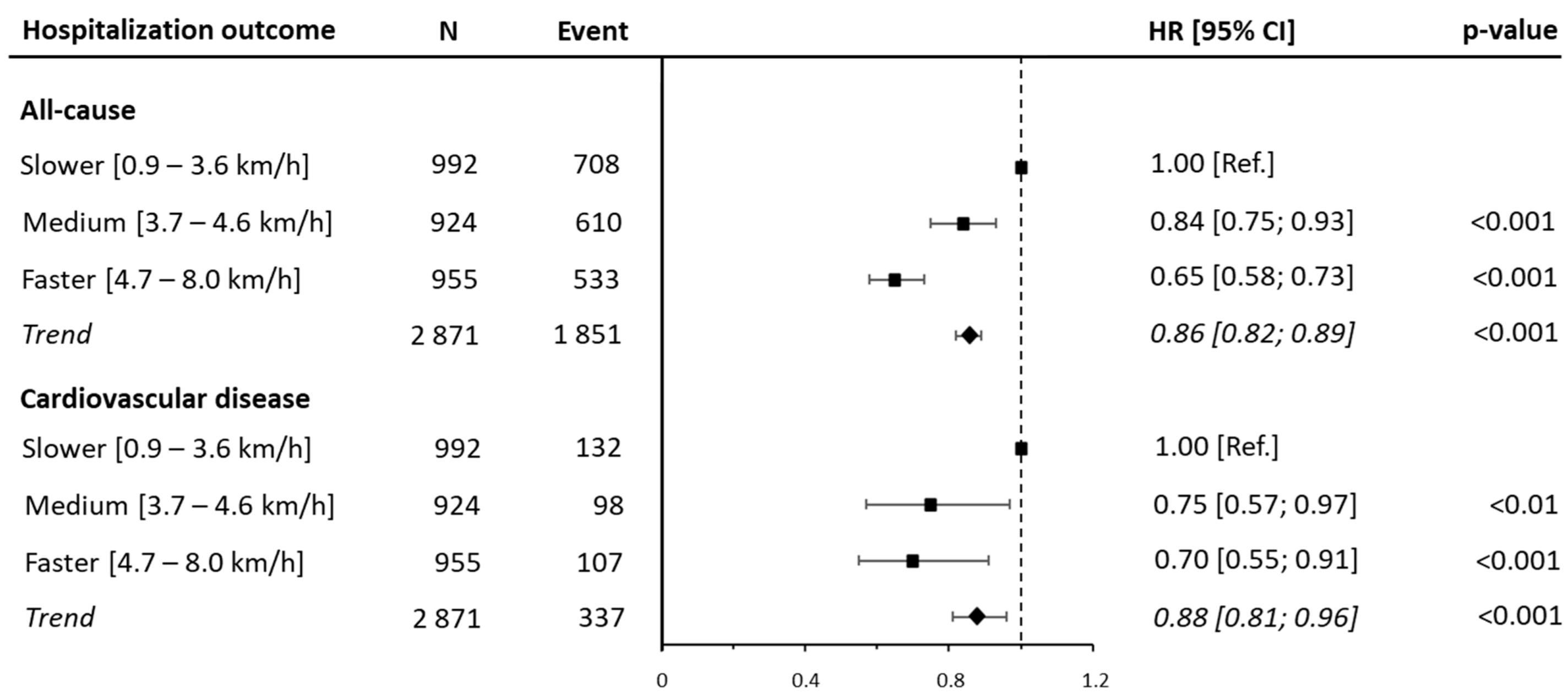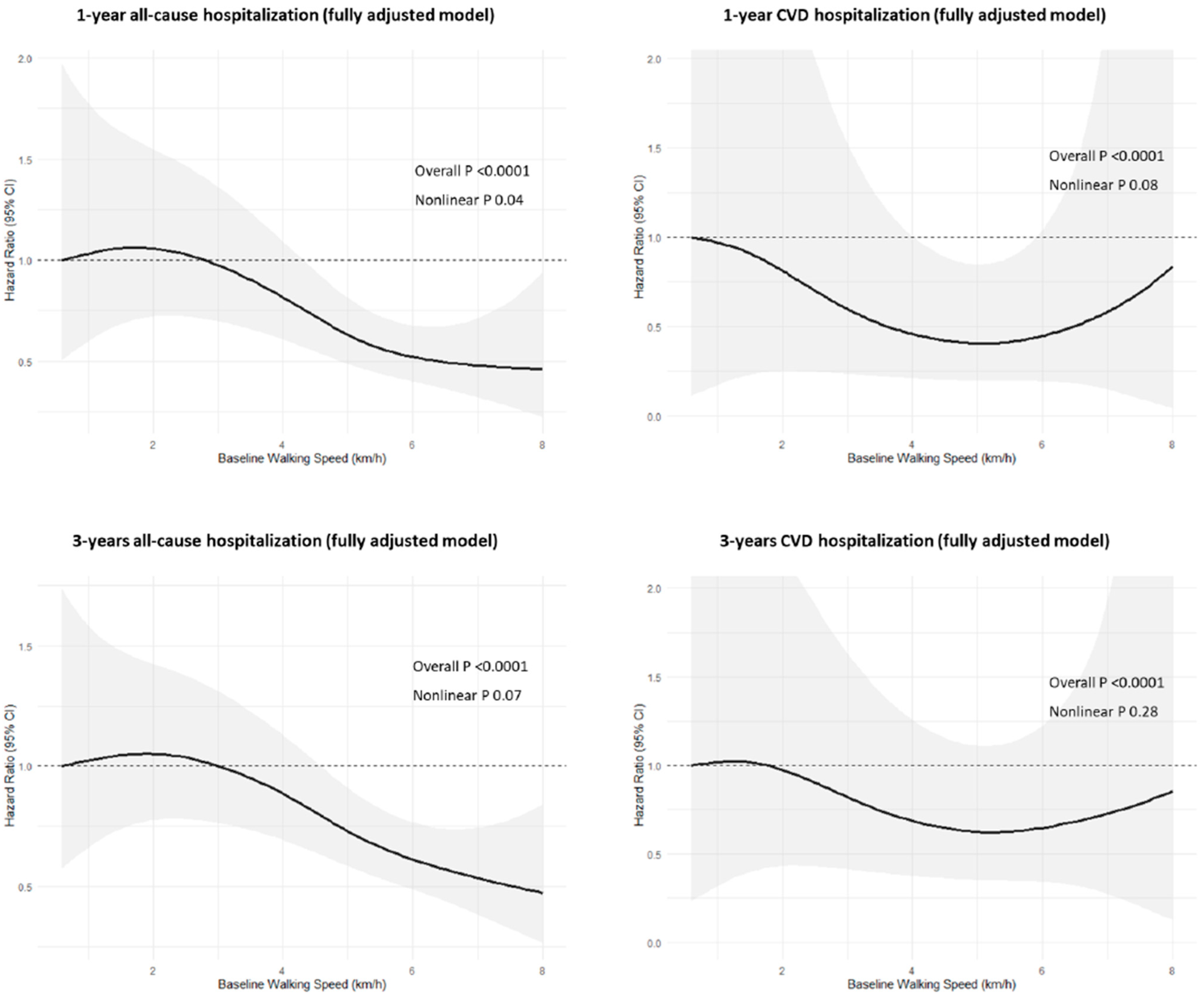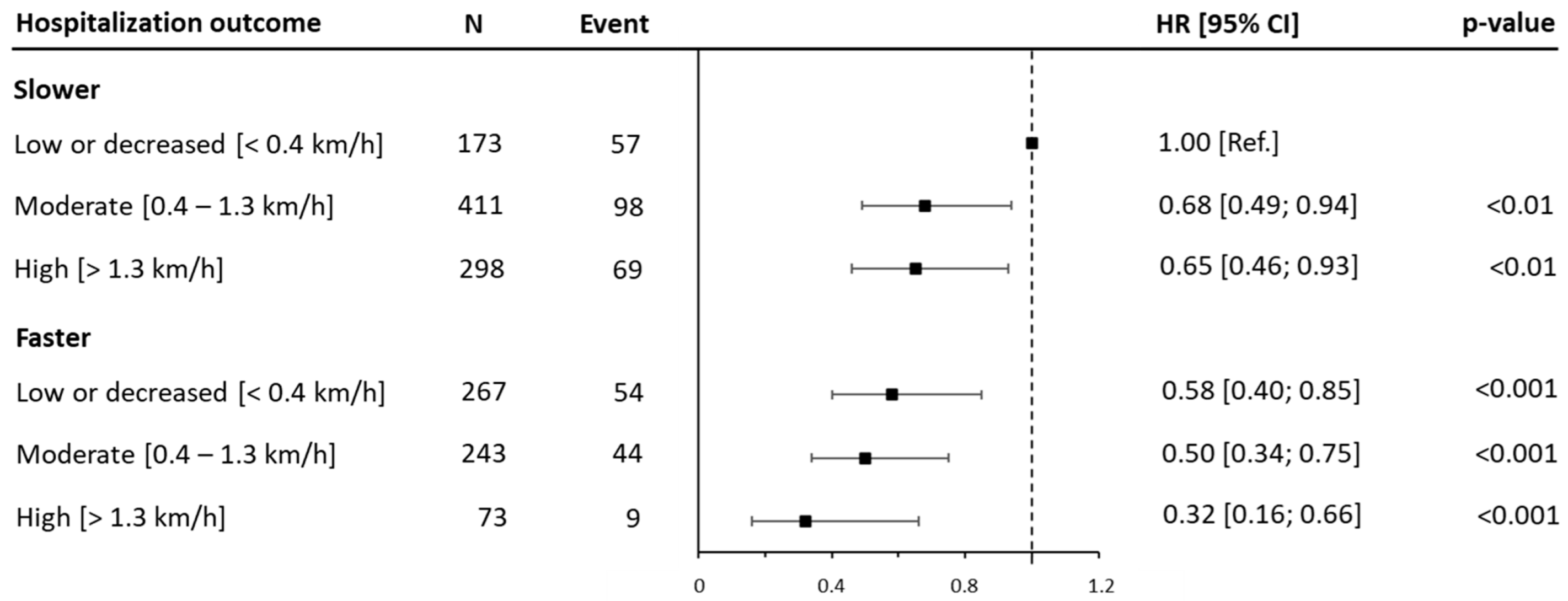Increased Walking Speed Reduces Hospitalization Rates in Patients with Cardiovascular Disease During Exercise-Based Secondary Prevention
Abstract
1. Introduction
2. Materials and Methods
2.1. The Source and the Study Population
2.2. Measures
2.3. The Exercise Intervention
2.4. Follow-Up and Hospitalization
2.5. The Statistical Analysis
3. Results
3.1. Association of Baseline WS with All-Cause and Cardiovascular Disease Hospitalization Risk
3.2. Joint Associations of WS Changes with All-Cause Hospitalization Risk
4. Discussion
4.1. Clinical Implications
4.2. Limitations of This Study
5. Conclusions
Supplementary Materials
Author Contributions
Funding
Institutional Review Board Statement
Informed Consent Statement
Data Availability Statement
Acknowledgments
Conflicts of Interest
Abbreviations
| CVD | Cardiovascular Disease |
| WS | Walking Speed |
| AMI | Acute Myocardial Infarction |
| PCI | Percutaneous Coronary Intervention |
| CABG | Coronary Artery Bypass Graft |
| DAG | Directed Acyclic Graph |
| 1 km-TWT | 1 km Treadmill Walking Test |
| BMI | Body Mass Index |
| HR | Hazard Ratio |
| CI | Confidence Interval |
References
- World Health Organization. Cardiovascular Diseases (CVDs). Available online: https://www.who.int/news-room/fact-sheets/detail/cardiovascular-diseases-(cvds) (accessed on 29 August 2023).
- Warren-Gash, C.; Davidson, J.A.; Strongman, H.; Herrett, E.; Smeeth, L.; Breuer, J.; Banerjee, A. Severe COVID-19 outcomes by cardiovascular risk profile in England in 2020: A population-based cohort study. Lancet Reg. Health Eur. 2023, 27, 100604. [Google Scholar] [CrossRef]
- Ades, P.A. Cardiac rehabilitation and secondary prevention of coronary heart disease. N. Engl. J. Med. 2001, 345, 892–902. [Google Scholar] [CrossRef]
- Redfern, J.; Gallagher, R.; O’Neil, A.; Grace, S.L.; Bauman, A.; Jennings, G.; Brieger, D.; Briffa, T. Historical Context of Cardiac Rehabilitation: Learning From the Past to Move to the Future. Front. Cardiovasc. Med. 2022, 9, 842567. [Google Scholar] [CrossRef] [PubMed]
- Luengo-Fernandez, R.; Walli-Attaei, M.; Gray, A.; Torbica, A.; Maggioni, A.P.; Huculeci, R.; Bairami, F.; Aboyans, V.; Timmis, A.D.; Vardas, P.; et al. Economic burden of cardiovascular diseases in the European Union: A population-based cost study. Eur. Heart J. 2023, 44, 4752–4767. [Google Scholar] [CrossRef] [PubMed]
- European Society of Cardiology. Price Tag on Cardiovascular Disease in Europe Higher than Entire EU Budget. 2023. Available online: https://www.eurekalert.org/news-releases/999753 (accessed on 29 August 2023).
- Taylor, R.S.; Dalal, H.M.; McDonagh, S.T.J. The role of cardiac rehabilitation in improving cardiovascular outcomes. Nat. Rev. Cardiol. 2022, 19, 180–194. [Google Scholar] [CrossRef]
- Oldridge, N.; Taylor, R.S. Cost-effectiveness of exercise therapy in patients with coronary heart disease, chronic heart failure and associated risk factors: A systematic review of economic evaluations of randomized clinical trials. Eur. J. Prev. Cardiol. 2020, 27, 1045–1055. [Google Scholar] [CrossRef] [PubMed]
- Knuuti, J.; Wijns, W.; Saraste, A.; Capodanno, D.; Barbato, E.; Funck-Brentano, C.; Prescott, E.; Storey, R.F.; Deaton, C.; Cuisset, T.; et al. 2019 ESC Guidelines for the diagnosis and management of chronic coronary syndromes: The Task Force for the diagnosis and management of chronic coronary syndromes of the European Society of Cardiology (ESC). Eur. Heart J. 2020, 41, 407–477. [Google Scholar] [CrossRef]
- Bohannon, R.W.; Andrews, A.W. Normal walking speed: A descriptive meta-analysis. Physiotherapy 2011, 97, 182–189. [Google Scholar] [CrossRef]
- CDC Vital Signs, More People Walk to Better Health. Available online: http://www.cdc.gov/vitalsigns/pdf/2012-08-vitalsigns.pdf (accessed on 29 August 2023).
- van Kan, G.A.; Rolland, Y.; Andrieu, S.; Bauer, J.; Beauchet, O.; Bonnefoy, M.; Cesari, M.; Donini, L.M.; Guyonnet, S.G.; Inzitari, M.; et al. Gait speed at usual pace as a predictor of adverse outcomes in community-dwelling older people an International Academy on Nutrition and Aging (IANA) Task Force. J. Nutr. Health Aging 2009, 13, 881–889. [Google Scholar] [CrossRef]
- Stamatakis, E.; Williamson, C.; Kelly, P.; Strain, T.; Murtagh, E.M.; Ding, D.; Murphy, M.H. Infographic. Self-rated walking pace and all-cause, cardiovascular disease and cancer mortality: Individual participant pooled analysis of 50 225 walkers from 11 population British cohorts. Br. J. Sports Med. 2019, 53, 1381–1382. [Google Scholar] [CrossRef]
- Jayedi, A.; Zargar, M.-S.; Emadi, A.; Aune, D. Walking speed and the risk of type 2 diabetes: A systematic review and meta-analysis. Br. J. Sports Med. 2024, 58, 334–342. [Google Scholar] [CrossRef]
- Studenski, S.; Perera, S.; Patel, K.; Rosano, C.; Faulkner, K.; Inzitari, M.; Brach, J.; Chandler, J.; Cawthon, P.; Connor, E.B.; et al. Gait speed and survival in older adults. JAMA 2011, 305, 50–58. [Google Scholar] [CrossRef] [PubMed]
- Veronese, N.; Stubbs, B.; Volpato, S.; Zuliani, G.; Maggi, S.; Cesari, M.; Lipnicki, D.M.; Smith, L.; Schofield, P.; Firth, J.; et al. Association Between Gait Speed With Mortality, Cardiovascular Disease and Cancer: A Systematic Review and Meta-analysis of Prospective Cohort Studies. J. Am. Med. Dir. Assoc. 2018, 19, 981–988.e7. [Google Scholar] [CrossRef]
- Pulignano, G.; Del Sindaco, D.; Di Lenarda, A.; Alunni, G.; Senni, M.; Tarantini, L.; Cioffi, G.; Tinti, M.D.; Barbati, G.; Minardi, G.; et al. IMAGE-HF Study Investigators, Incremental Value of Gait Speed in Predicting Prognosis of Older Adults With Heart Failure: Insights From the IMAGE-HF Study. JACC Heart Fail 2016, 4, 289–298. [Google Scholar] [CrossRef] [PubMed]
- Matsuzawa, Y.; Konishi, M.; Akiyama, E.; Suzuki, H.; Nakayama, N.; Kiyokuni, M.; Sumita, S.; Ebina, T.; Kosuge, M.; Hibi, K.; et al. Association between gait speed as a measure of frailty and risk of cardiovascular events after myocardial infarction. J. Am. Coll. Cardiol. 2013, 61, 1964–1972. [Google Scholar] [CrossRef]
- Beatty, A.L.; Schiller, N.B.; Whooley, M.A. Six-minute walk test as a prognostic tool in stable coronary heart disease: Data from the heart and soul study. Arch. Intern. Med. 2012, 172, 1096–1102. [Google Scholar] [CrossRef]
- Grazzi, G.; Mazzoni, G.; Myers, J.; Codecà, L.; Pasanisi, G.; Napoli, N.; Guerzoni, F.; Volpato, S.; Conconi, F.; Chiaranda, G. Improved walking speed is associated with lower hospitalisation rates in patients in an exercise-based secondary prevention programme. Heart 2016, 102, 1902–1908. [Google Scholar] [CrossRef] [PubMed]
- Grazzi, G.; Mazzoni, G.; Myers, J.; Caruso, L.; Sassone, B.; Pasanisi, G.; Guerzoni, F.; Napoli, N.; Pizzolato, M.; Zerbini, V.; et al. Impact of Improvement in Walking Speed on Hospitalization and Mortality in Females with Cardiovascular Disease. J. Clin. Med. 2020, 9, 1755. [Google Scholar] [CrossRef]
- Bonnini, S.; Mazzoni, G.; Borghesi, M.; Chiaranda, G.; Myers, J.; Mandini, S.; Raisi, A.; Masotti, S.; Grazzi, G. Improving walking speed reduces hospitalization costs in outpatients with cardiovascular disease. An analysis based on a multistrata non-parametric test. BMC Health Serv. Res. 2020, 20, 1048. [Google Scholar] [CrossRef]
- McEvoy, J.W.; McCarthy, C.P.; Bruno, R.M.; Brouwers, S.; Canavan, M.D.; Ceconi, C.; Christodorescu, R.M.; Daskalopoulou, S.S.; Ferro, C.J.; Gerdts, E.; et al. 2024 ESC Guidelines for the management of elevated blood pressure and hypertension. Eur. Heart J. 2024, 45, 3912–4018. [Google Scholar] [CrossRef]
- Chiaranda, G.; Myers, J.; Mazzoni, G.; Terranova, F.; Bernardi, E.; Grossi, G.; Codecà, L.; Conconi, F.; Grazzi, G. Peak oxygen uptake prediction from a moderate, perceptually regulated, 1-km treadmill walk in male cardiac patients. J. Cardiopulm. Rehabil. Prev. 2012, 32, 262–269. [Google Scholar] [CrossRef] [PubMed]
- Zerbini, V.; Raisi, A.; Myers, J.; Piva, T.; Lordi, R.; Chiaranda, G.; Mazzoni, G.; Grazzi, G.; Mandini, S. Peak Oxygen Uptake Estimation From A Moderate 1-KM Treadmill Walk in Women With Cardiovascular Disease. J. Cardiopulm. Rehabil. Prev. 2021, 41, 432–434. [Google Scholar] [CrossRef] [PubMed]
- Mazzoni, G.; Sassone, B.; Pasanisi, G.; Myers, J.; Mandini, S.; Volpato, S.; Conconi, F.; Chiaranda, G.; Grazzi, G. A moderate 500-m treadmill walk for estimating peak oxygen uptake in men with NYHA class I-II heart failure and reduced left ventricular ejection fraction. BMC Cardiovasc. Disord. 2018, 18, 67. [Google Scholar] [CrossRef]
- Mazzoni, G.; Chiaranda, G.; Myers, J.; Sassone, B.; Pasanisi, G.; Mandini, S.; Volpato, S.; Conconi, F.; Grazzi, G. 500-meter and 1000-meter moderate walks equally assess cardiorespiratory fitness in male outpatients with cardiovascular diseases. J. Sports Med. Phys. Fitness 2018, 58, 1312–1317. [Google Scholar] [CrossRef]
- Mazzoni, G.; Myers, J.; Sassone, B.; Pasanisi, G.; Mandini, S.; Raisi, A.; Pizzolato, M.; Franchi, M.; Caruso, L.; Missiroli, L.; et al. A moderate 200-m walk test estimates peak oxygen uptake in elderly outpatients with cardiovascular disease. J. Sports Med. Phys. Fitness 2020, 60, 786–793. [Google Scholar] [CrossRef] [PubMed]
- Raisi, A.; Zerbini, V.; Myers, J.; Piva, T.; Campo, G.; Mazzoni, G.; Grazzi, G.; Mandini, S. A Novel Motivational Approach in the Management of Older Patients With Cardiovascular Disease. J. Cardiopulm Rehabil. Prev. 2023, 43, 309–310. [Google Scholar] [CrossRef]
- Textor, J.; van der Zander, B.; Gilthorpe, M.S.; Liskiewicz, M.; Ellison, G.T. Robust causal inference using directed acyclic graphs: The R package “dagitty”. Int. J. Epidemiol. 2016, 45, 1887–1894. [Google Scholar] [CrossRef]
- Maathuis, M.H.; Colombo, D. A generalized back-door criterion. Ann. Stat. 2015, 43, 1060–1088. [Google Scholar] [CrossRef]
- Govindarajulu, U.S.; Malloy, E.J.; Ganguli, B.; Spiegelman, D.; Eisen, E.A. The comparison of alternative smoothing methods for fitting non-linear exposure-response relationships with Cox models in a simulation study. Int. J. Biostat. 2009, 5, 2. [Google Scholar] [CrossRef]
- Dolgin, M. Nomenclature and Criteria for Diagnosis of Diseases of the Heart and Great Vessels, 9th ed.; Little, Brown: Boston, MA, USA, 1994. [Google Scholar]
- Ambrosetti, M.; Abreu, A.; Corrà, U.; Davos, C.H.; Hansen, D.; Frederix, I.; Iliou, M.C.; Pedretti, R.F.; Schmid, J.-P.; Vigorito, C.; et al. Secondary prevention through comprehensive cardiovascular rehabilitation: From knowledge to implementation. 2020 update. A position paper from the Secondary Prevention and Rehabilitation Section of the European Association of Preventive Cardiology. Eur. J. Prev. Cardiol. 2020, 28, 460–495. [Google Scholar] [CrossRef]
- Wilson, M.G.; Ellison, G.M.; Cable, N.T. Basic science behind the cardiovascular benefits of exercise. Br. J. Sports Med. 2016, 50, 93–99. [Google Scholar] [CrossRef] [PubMed]
- Jernberg, T.; Hasvold, P.; Henriksson, M.; Hjelm, H.; Thuresson, M.; Janzon, M. Cardiovascular risk in post-myocardial infarction patients: Nationwide real world data demonstrate the importance of a long-term perspective. Eur. Heart J. 2015, 36, 1163–1170. [Google Scholar] [CrossRef] [PubMed]
- Taniguchi, T.; Shiomi, H.; Morimoto, T.; Watanabe, H.; Ono, K.; Shizuta, S.; Kato, T.; Saito, N.; Kaji, S.; Ando, K.; et al. Incidence and Prognostic Impact of Heart Failure Hospitalization During Follow-Up After Primary Percutaneous Coronary Intervention in ST-Segment Elevation Myocardial Infarction. Am. J. Cardiol. 2017, 119, 1729–1739. [Google Scholar] [CrossRef] [PubMed]
- Oja, P.; Laukkanen, R.; Pasanen, M.; Tyry, T.; Vuori, I. A 2-km walking test for assessing the cardiorespiratory fitness of healthy adults. Int. J. Sports Med. 1991, 12, 356–362. [Google Scholar] [CrossRef]





| Variable | All Patients (n = 2 871) | Slower (n = 992) | Medium (n = 924) | Faster (n = 955) | p-Value |
|---|---|---|---|---|---|
| Measured walking speed (km/h) | |||||
| Mean (SD) | 4.1 (1.2) | 2.8 (0.6) | 4.2 (0.3) | 5.4 (0.6) | <0.0001 |
| Range (min/max) | 1.3–8.0 | 1.3–3.6 | 3.7–4.6 | 4.7–8.0 | |
| Demographics | |||||
| Age (yr) | 65 (11) | 67 (10) | 64 (10) | 63 (11) | <0.001 |
| Sex (women, n, %) | 505 (18) | 256 (26) | 125 (14) | 124 (13) | <0.001 |
| BMI (Kg/m2) | 27.4 (4.0) | 27.6 (4.2) | 27.5 (3.8) | 27.2 (4.0) | 0.078 |
| LV ejection fraction (%) | 58 (9) | 57 (8) | 58 (9) | 58 (11) | <0.01 |
| Marital status (married, %) | 2296 (80) | 767 (77) | 765 (83) | 764 (80) | <0.05 |
| Education (high school, %) | 1313 (46) | 417 (42) | 429 (46) | 467 (49) | <0.01 |
| Risk factors | |||||
| Family history (n, %) | 1202 (42) | 375 (38) | 376 (41) | 451 (47) | <0.001 |
| Hypertension (n, %) | 1745 (61) | 660 (67) | 518 (56) | 567 (59) | <0.001 |
| Diabetes (n, %) | 501 (17) | 201 (20) | 134 (15) | 166 (17) | <0.01 |
| Current smoking (n, %) | 639 (22) | 200 (20) | 200 (22) | 239 (25) | <0.05 |
| Hemoglobin (mg/dL) | 13.5 (1.9) | 13.4 (1.9) | 13.5 (1.9) | 13.6 (1.8) | 0.060 |
| Total cholesterol (mg/dL) | 183 (48) | 185 (51) | 184 (45) | 180 (46) | 0.120 |
| HDL cholesterol (mg/dL) | 49 (15) | 49 (15) | 49 (16) | 49 (14) | 0.840 |
| Serum triglycerides (mg/dL) | 132 (69) | 131 (70) | 133 (66) | 132 (70) | 0.130 |
| Serum creatinine (mg/dL) | 1.07 (0.32) | 1.09 (0.31) | 1.08 (0.32) | 1.05 (0.34) | <0.001 |
| Medical history | |||||
| Myocardial infarction (n, %) | 1399 (49) | 484 (49) | 473 (51) | 442 (46) | 0.100 |
| PCI (n, %) | 801 (28) | 216 (22) | 260 (28) | 325 (34) | <0.001 |
| CABG (n, %) | 1110 (39) | 427 (43) | 365 (40) | 318 (33) | <0.001 |
| Valvular replacement (n, %) | 481 (17) | 205 (21) | 143 (15) | 133 (14) | <0.001 |
| Other (n, %) | 534 (19) | 182 (18) | 149 (16) | 203 (21) | <0.05 |
| Medications | |||||
| ACE inhibitor or ARB (n, %) | 1673 (58) | 572 (58) | 535 (58) | 566 (59) | 0.740 |
| Aspirin (n, %) | 2105 (73) | 656 (66) | 678 (73) | 771 (81) | <0.001 |
| B-blocker (n, %) | 1939 (68) | 652 (66) | 648 (70) | 639 (67) | 0.110 |
| Calcium antagonist (n, %) | 531 (18) | 218 (22) | 162 (18) | 151 (16) | <0.01 |
| Statin (n, %) | 1788 (62) | 537 (54) | 582 (63) | 669 (70) | <0.001 |
| Diuretic (n, %) | 670 (23) | 362 (36) | 188 (20) | 120 (13) | <0.001 |
Disclaimer/Publisher’s Note: The statements, opinions and data contained in all publications are solely those of the individual author(s) and contributor(s) and not of MDPI and/or the editor(s). MDPI and/or the editor(s) disclaim responsibility for any injury to people or property resulting from any ideas, methods, instructions or products referred to in the content. |
© 2025 by the authors. Licensee MDPI, Basel, Switzerland. This article is an open access article distributed under the terms and conditions of the Creative Commons Attribution (CC BY) license (https://creativecommons.org/licenses/by/4.0/).
Share and Cite
Raisi, A.; Piva, T.; Myers, J.; Zerbini, V.; Menegatti, E.; Lembo, M.; Michelon, S.; Meneghini, I.; Grazzi, G.; Mazzoni, G.; et al. Increased Walking Speed Reduces Hospitalization Rates in Patients with Cardiovascular Disease During Exercise-Based Secondary Prevention. J. Clin. Med. 2025, 14, 4583. https://doi.org/10.3390/jcm14134583
Raisi A, Piva T, Myers J, Zerbini V, Menegatti E, Lembo M, Michelon S, Meneghini I, Grazzi G, Mazzoni G, et al. Increased Walking Speed Reduces Hospitalization Rates in Patients with Cardiovascular Disease During Exercise-Based Secondary Prevention. Journal of Clinical Medicine. 2025; 14(13):4583. https://doi.org/10.3390/jcm14134583
Chicago/Turabian StyleRaisi, Andrea, Tommaso Piva, Jonathan Myers, Valentina Zerbini, Erica Menegatti, Margherita Lembo, Sofia Michelon, Isabella Meneghini, Giovanni Grazzi, Gianni Mazzoni, and et al. 2025. "Increased Walking Speed Reduces Hospitalization Rates in Patients with Cardiovascular Disease During Exercise-Based Secondary Prevention" Journal of Clinical Medicine 14, no. 13: 4583. https://doi.org/10.3390/jcm14134583
APA StyleRaisi, A., Piva, T., Myers, J., Zerbini, V., Menegatti, E., Lembo, M., Michelon, S., Meneghini, I., Grazzi, G., Mazzoni, G., & Mandini, S. (2025). Increased Walking Speed Reduces Hospitalization Rates in Patients with Cardiovascular Disease During Exercise-Based Secondary Prevention. Journal of Clinical Medicine, 14(13), 4583. https://doi.org/10.3390/jcm14134583





